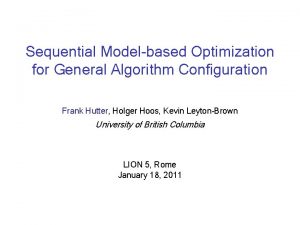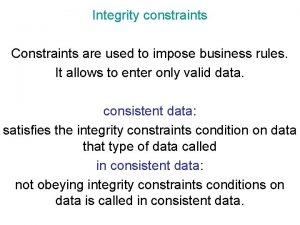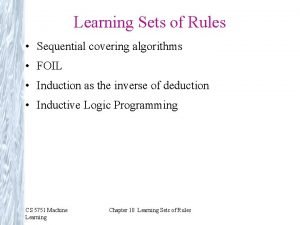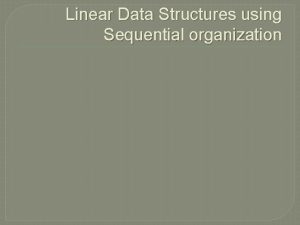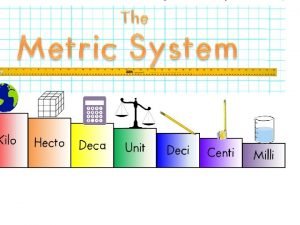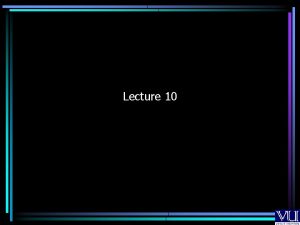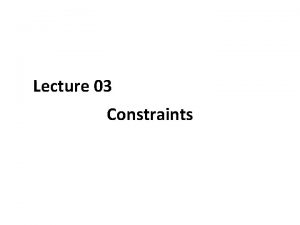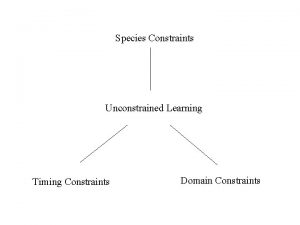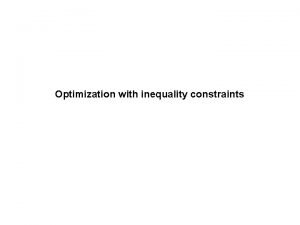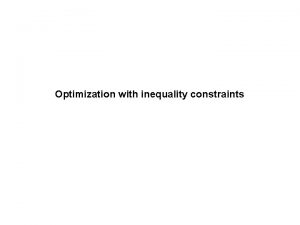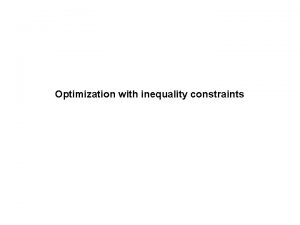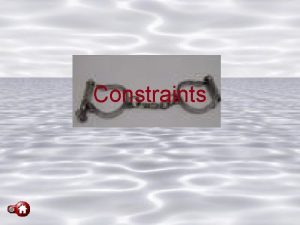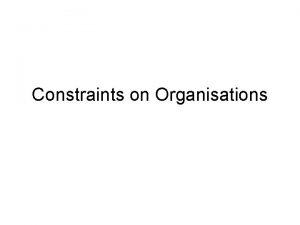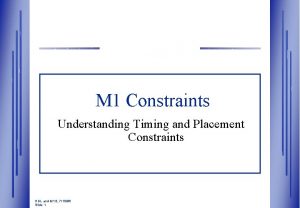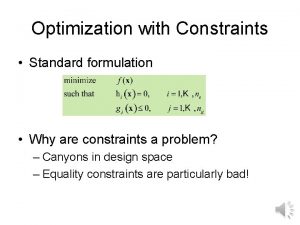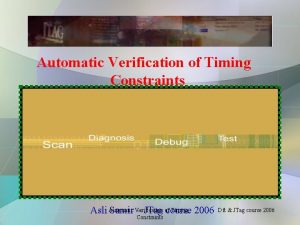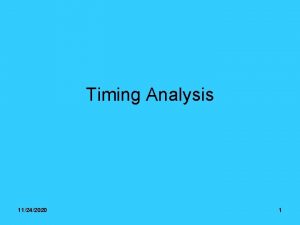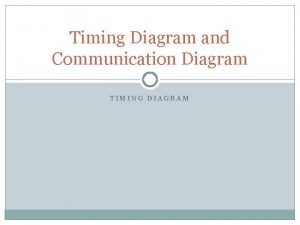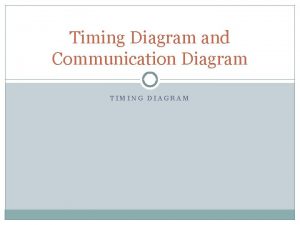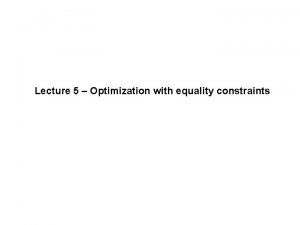Sequential Timing Optimization Long path timing constraints Data





















- Slides: 21

Sequential Timing Optimization

Long path timing constraints • Data must not reach destination FF too late i dmax(i, j) si + d(i, j) + Tsetup sj + P j si sj d(i, j) Tsetup

Short path timing constraints • FF should not get >1 data set period i dmin(i, j) si + dmin(i, j) sj + Thold j si sj dmin(i, j) Thold

Clock skew optimization • Another approach for sequential timing optimization • Deliberately change the arrival times of the clock at various memory elements in a circuit for cycle borrowing – For zero skew, delay from clock source to all FF’s = T – Positive skew of at FFk • Change delay from clock source to FFk to T + – Negative skew of at FFk • Change delay from clock source to FFk to T – • Problem statement: set skews for optimized performance

Sequential timing optimization • Two “true” sequential timing optimization methods – Retiming: moving latches around in a design Comb Block 1 Comb Block 2 FF FF FF Clk Clk Clk – Clock skew optimization: deliberately changing clock arrival times so that the circuit is not truly “synchronous” Comb Block 1 Comb Block 2 FF FF Clk Clk Clk FF FF Delay Clk

Finding the optimal clock period using skews • Represented by the optimization problem below - solve for P and optimal skews minimize P subject to (for all pairs of FF’s (i, j) connected by a combinational path) si + dmin(i, j) sj + Thold si + dmax(i, j) + Tsetup sj + P • If dmax(i, j) and dmin(i, j) are constant – linear program in the variables si and P

Graph-based approaches • For a constant clock period P, the linear program = system of difference constraints sp - sq constant • As before, perform a binary search on P • For each value of P build an equivalent constraint graph i f(P) j • Shortest path in the constraint graph gives a set of skews for a given value of P • If P is infeasible, there will be a negative cycle in the graph that will be detected during shortest-path calculations

Retiming Assume unit gate delays, no setup times Comb Block 1 Comb Block 2 FF FF FF Clk Clk Initial Circuit: P=3 FF FF FF Clk Clk Retimed Circuit: P=2

Retiming: Definition • Relocation of flip-flops (FF’s) and latches (usually to achieve lower clock periods) • Maintain the latency of all paths in circuit, i. e. , number of FF stages on any input-output path must remain unchanged

Graph Notation of Circuit u v u w(euv) = 2 delay = d(u) v delay = d(v) w(euv) = #latencies between u and v r(u) is # latencies moved across gate u r(PI) = r(PO) = 0: Merge them both into a “host” node h with r(h) = 0 wr(euv) = w(euv) + r(v) - r(u) u r(u) = 1 w(euv) = 1 v r(v) = 2 u wr(euv) = 2 v

For a path from v 1 to vk • Consider a path of vertices v 1 w 12 v 2 w 23 v 3 w 34 vk Wk-1, k – Define w(v 1 to vk) = w 12 + w 23 + … + w(k-1, k) – After retiming, wr(v 1 to vk) = w 12 r + w 23 r + … + w(k-1, k)r = [w 12+r(2)–r(1)]+[w 23+r(3)–r(2)]+…+[w(k-1, k)+r(k)–r(k-1)] = w(v 1 to vk) + r(k) – r(1) – For a cycle, v 1 = vk, which implies that wr = w for a cycle – In other words, retiming leaves the # latencies unchanged on any cycle

Constraints for retiming • Non-negativity constraints (cannot have negative latencies) – wr on each edge must be non-negative – For any edge from vertex u to vertex v, wr(u, v) = w(u, v) + r(v) – r(u) 0 i. e. , r(u) – r(v) w(u, v) • Period constraints (need a latency if path delay period) – (or more precisely, path delay + Tsetup period) – For any path from vertex v 1 to vertex vk, under clock period P, wr(v 1 to vk) = w(v 1 to vk) + r(vk) – r(v 1) 1 if delay(v 1 to vk) > P i. e. , r(v 1) – r(vk) w(v 1 to vk) – 1 if delay(v 1 to vk) > P

Comb Block 1 FF Example G 2 G 1 • – Vertex weights = gate delays – Edge weights = # latencies 0 h 0 0 0 G 2 1 1 0 1 G 3 G 4 Non-negativity constraints 1. 2. 3. 4. 5. • 1 G 4 G 1 1 G 3 FF Clk • Circuit graph: Comb Block 2 r(h) – r(G 1) 0 r(G 1) – r(G 2) 0 r(G 2) – r(G 3) 0 r(G 3) – r(G 4) 1 r(G 4) – r(h) 0 Period constraints for P = 2 6. 7. 8. 9. r(h) – r(G 3) -1 r(G 1) – r(G 3) -1 r(G 2) – r(G 4) 0 r(G 2) – r(h) 0 FF Clk

Graph-based approaches • System of difference constraints r(u) – r(v) c • Equivalent constraint graph v c u • Shortest path in the constraint graph gives a set of valid r values for a given value of P (note that period constraints change for different values of P) • If P is infeasible, there will be a negative cycle in the graph that will be detected during shortest-path calculations

Corresponding shortest path problem h • Find shortest path from host to get 0 – – – r(h) = 0 r(G 1) = 0 r(G 2) = 0 r(G 3) = 1 r(G 4) = 0 G 1 0 0 G 4 0 0 -1 1 0 G 2 G 3 • This gives the solution Comb Block 1 Comb Block 2 FF FF FF Clk Clk Clk -1

Overall scheme for minimum period retiming • Objective: to find a retiming that minimizes the clock period (the assignment of r values may not be unique due to slack in the shortest path graph!) – – Binary search over P = [0, Punretimed] Punretimed = period of unretimed circuit = upper bound on optimal P Range in some iteration of the search = [Pmin, Pmax] Build shortest path graph with non-negativity constraints (independent of P) – At each value of P • Add period constraints to shortest path graph (related to W, D matrices discussed in class – will not describe here) • Solve shortest path problem • If negative cycle found, set Pmin = P; else set Pmax = P • Iterate until range of P is sufficiently small

Finding shortest paths • Dijkstra’s algorithm – O(Vlog. V + E) for a graph with V vertices and E edges – Applicable only if all edge weights are non-negative – The latter condition does not hold in our case! • Bellman-Ford algorithm – O(VE) for a graph with V vertices and E edges – Outline for I = 1 to V – 1 for each edge (u, v) E update neighbor’s weights as r(v) = min[r(u) + d(u, v), r(v)] for each edge (u, v) E if r(u) + d(u, v) > r(v) then a negative cycle exists • Basic idea: in iteration I, update lowest cost path with I edges • After V – 1 iterations, if any update is still required, a negative cycle exists

“Relaxation” algorithm for retiming • • Perform a binary search on clock period P as before At each value of P check feasibility as follows – Repeat V-1 times (where V = # vertices) 1. 2. 3. 4. 5. Set r(u) = 0 for each vertex Perform timing analysis to find clock period of the circuit For any vertex u with delay > P, r(u)++ If no such vertex exists, P is feasible Else, retime the circuit using these values of r; update the circuit and go to step 1 – If Clock period > P after V – 1 iterations, then P is infeasible

The retiming-skew relationship • Skew Comb Block 1 Comb Block 2 FF FF FF Delay = 1 Clk Clk FF FF FF Clk Clk • Retiming • Both borrow one unit of time from Comb Block 2 and lend it to Comb Block 1 • Magnitude of optimal skew = amount of delay that the FF has to move across • Can be generalized for another approach to retiming

Can move from skews to retiming • Moving a flip-flop across a gate G – left right �increasing its skew by delay(G) – • More generally, s 1 s 2 s 3 Delay=d Old skew=s s 4 New skew = s+d – right left ��reducing its skew by delay(G) – FF j sj = max 1 i 4 (si+MAX(i, j)) FF k sk = max 1 i 4 (si+MAX(i, k))

Another approach to retiming • Two-phase approach – Phase A: Find optimal skews (complexity depends on the number of FF’s, not the number of gates) – Phase B: Relocate FF’s to retime circuit (since most FF movements are seen to be local in practice, this does not take too long) – Not provably better than earlier approach in terms of complexity, but practically works very well
 Sequential model based optimization
Sequential model based optimization Sequential minimal optimization algorithm
Sequential minimal optimization algorithm Short short short long long long short short short
Short short short long long long short short short Once upon a time there lived a little country girl
Once upon a time there lived a little country girl Hot path cold path
Hot path cold path Data integrity constraints are used to
Data integrity constraints are used to Long path propagation
Long path propagation Long path propagation
Long path propagation Data pipeline optimization
Data pipeline optimization Data warehouse optimization mistakes
Data warehouse optimization mistakes Data mining driven manufacturing process optimization
Data mining driven manufacturing process optimization Concept of sequential organization in data structure
Concept of sequential organization in data structure ____ is a sequential action in data curation
____ is a sequential action in data curation Sequential covering algorithm in data mining
Sequential covering algorithm in data mining Given the base address of an array b 1300
Given the base address of an array b 1300 Long time ago people
Long time ago people Once there lived an old king with
Once there lived an old king with Props of tinikling
Props of tinikling Once upon a time a long long time ago begins the story
Once upon a time a long long time ago begins the story Long long int c
Long long int c Long long ago when the gods and goddesses
Long long ago when the gods and goddesses Lông vằn lông vện mắt xanh
Lông vằn lông vện mắt xanh
